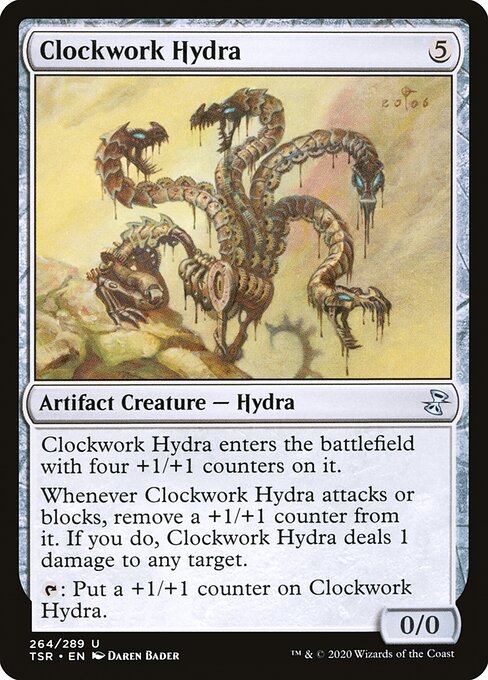
Image courtesy of Scryfall.com
Rarity Tiers and Perceived Value: A Clockwork Hydra Case Study
In Magic: The Gathering, rarity is rarely just about how strong a card is in a vacuum. It’s a cultural signal, a conversation starter, and sometimes a currency you carry in sleeves and binders. Clockwork Hydra, an artifact creature from Time Spiral Remastered, sits at uncommon rarity yet invites a richer discussion about how scarcity, nostalgia, and playability intersect to shape perceived value 🧙♂️🔥. The Hydra’s design embodies clarity and cleverness—the kind of card that looks simple at first glance but rewards deeper inspection as you draft, play, and trade.
Let’s pin down what Clockwork Hydra actually does. For five colorless mana, you drop an artifact creature that enters with four +1/+1 counters, effectively arriving as a 4/4. The creature’s life cycle is a careful dance: whenever it attacks or blocks, you may remove a counter to deal 1 damage to any target. If you’ve got spare counters, you can lean into a fragile-but-resilient tempo game; otherwise, tapping to add another counter nudges it back toward staying power. This lightweight, counter-focused mechanic makes it a perfect runway for players who enjoy incremental value rather than brute force 🛠️🎯.
Time Spiral Remastered, the set in which Clockwork Hydra reappears, is a masterful example of how reprinting can balance nostalgia with accessibility. TSR preserves the familiar look and feel of classic cards while placing them into a modern, polished presentation. The result is a card that feels timeless on the table—puzzle-piece simple in its rules, yet satisfying in execution. In terms of rarity, uncommon slots are often overlooked by casual browsers, but the Hydra demonstrates that uncommon cards can still strike a chord with players who value dependable performance and interesting edges in a deck-building puzzle 💎.
From a market perspective, you don’t have to chase mythics to chase value. Clockwork Hydra’s current market numbers illustrate how rarity shapes perception just as much as mechanical power. Non-foil copies tend to hover around the low single digits in many markets, with listed prices around $0.11 USD. Foil versions carry a premium—foil prices around $0.32 USD reflect the allure of the glossy finish that catches the eye at casual tables and showy collection displays. This gap—the foil premium—often makes foils the aspirational “special” version for many players, even when the non-foil copy is perfectly serviceable on the battlefield 🔥💎.
Gameplay wise, Hydra embodies a measured, calculated tempo. Its presence demands a broader strategy: how do you steward those +1/+1 counters over multiple combat steps? The requirement to remove a counter to deal 1 damage creates a natural pacing mechanism; you’re not tossing counters away haphazardly, you’re trading durability for reach. Add the counter-adding ability to the mix, and you’ve got a card that rewards thoughtful sequencing more than sheer speed. In formats that love artifact synergies or +1/+1 counters, Clockwork Hydra can slide into a midrange or attrition strategy, offering a reliable beat while you assemble your longer-game plan 🧭⚔️.
Rarity also informs collector psychology. An uncommon card from a Masters-style reprint like Time Spiral Remastered may not spike in price the way a rare or mythic would during a standard-driven frenzy, but it carries a distinct charm for collectors who track set histories, print runs, and the evolution of card scarcity. The Hydra’s rarity, plus the allure of foil copies, can create a sense of value beyond raw power. It’s a reminder that value isn’t just about winning a game; it’s about owning a piece of the broader MTG tapestry—the story of an era, the glow of a foil, and the thrill of discovering a card that aged gracefully with time 🧙🏻♂️🎨.
Rarity is a narrative tool as much as a price tag. When a card lands in an uncommon slot but carries a robust, timeless mechanic, players and collectors alike feel the pull of both accessibility and aspiration.
For players and casual collectors who love the tactile ritual of drawing and drafting, Clockwork Hydra offers a concrete example of how the social economy of MTG works in practice. You’re balancing card power, scarcity signals, and the tactile joy of a well-printed piece. And while the card’s value in a vacuum might be modest, its place in a well-curated collection or a thoughtfully built EDH or casual deck can feel substantial. The experience is as much about community and memory as it is about math and mana ☄️🧩.
To bring the discussion full circle, consider how this Hydra sits alongside other uncommon artifacts and creature-counters cards in various formats. Its five-mana imprint, four counters at arrival, and ping-on-attack/block create a niche where players who love counter synergy, artifact themes, and careful combat optimization can experiment with tempo-heavy lines. In the grand tapestry of rarity tiers, Clockwork Hydra demonstrates that value is multi-faceted: it’s about scarcity, design clarity, collector appeal, and the subtle joy of a well-timed counter move ⚙️🎲.
And for readers who like a little gear talk with their gear-grind, a quick reminder: your desk setup matters just as much as your deck. That neon gaming mouse pad you see linked below can keep your fingers nimble as you line up that perfect ping or plan your next counter-laden combo—because great games deserve great tools, both on the table and at the workstation 🚀🎨.
Neon Gaming Mouse Pad Rectangular 1-16 in Thick Rubber Base
Neon Gaming Mouse Pad Rectangular 1-16 in Thick Rubber Base
More from our network
- https://crypto-acolytes.xyz/blog/post/whats-new-in-the-minecraft-combat-update-pvp-changes/
- https://transparent-paper.shop/blog/post/monetize-templates-build-a-scalable-digital-business/
- https://blog.digital-vault.xyz/blog/post/master-instagram-reels-a-practical-strategy-guide/
- https://crypto-acolytes.xyz/blog/post/unlocking-replay-value-what-makes-games-timeless/
- https://crypto-acoly.xyz/blog/post/resident-evils-influence-on-modern-horror-and-game-design/